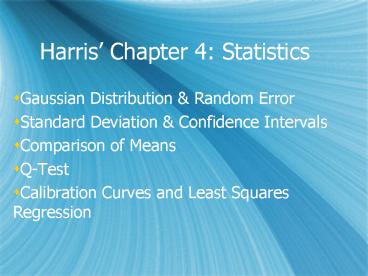Harris Chapter 4: Statistics PowerPoint PPT Presentation
1 / 22
Title: Harris Chapter 4: Statistics
1
Harris Chapter 4 Statistics
- Gaussian Distribution Random Error
- Standard Deviation Confidence Intervals
- Comparison of Means
- Q-Test
- Calibration Curves and Least Squares Regression
2
- The mean is sometimes called the arithmetic
average. - For analytical chemistry, we are normally
calculating the mean of 3 or more points in a set
of data - Reduced random or indeterminate error
- The closer the mean is to the true (sometimes
called accepted or known) value, the more
accuracy there is
3
- Standard deviation (s or STDEV) represents how
closely data is scattered about the mean. - n-1 is called the degrees of freedom
- A smaller standard deviation means there is less
variability in your data, or that your results
are more precise. - You have better precision
4
- What is the mean, standard deviation and percent
relative standard deviation (RSD) for blue MMs
in little bags of chocolate MMs
5
The Gaussian Curve
- A distribution of events occurring with
variations that are due to random errors
(indeterminate error) - Used to evaluate the distribution of random
variation about a mean value - Key to the mathematical definitions of mean and
standard deviation
6
(No Transcript)
7
(No Transcript)
8
(No Transcript)
9
Confidence Intervals
- Utilize students t tests. These were originally
developed by a brewer for Guinness. - Confidence intervals allow on to specify how
confident or certain they are that the true value
for a set of data lies within a specific range.
10
- The confidence interval is labeled (?)
- s is the standard deviation
- n is the number of measurements
- t is a statistical students t value
- When appropriate, confidence intervals are
expressed with units and are sometimes expressed
in sentence form.
11
(No Transcript)
12
(No Transcript)
13
Confidence Intervals are a statistical tool, and
a tool only! They do not supersede an analysts
experience or knowledge about the analysis or
sample, but can provide complimentary
information. What is the 95 confidence interval
for the number of MMs in a little bag of
chocolate MMs?
14
Comparison of Data with t-tests.
- Case 1 we can just see if the known or true
value falls within the confidence interval. - A little bag of chocolate MMs is supposed to
have 24 candies in it? Do our results include the
known value at the 90 confidence interval? - Case 2 Comparison of 2 data sets.
- Problem 4-14 as an example
15
- Compare 2 sets of data
- Calculate a standard deviation for each
- Calculate a t value (tcalculated)
- Compare tcalc to ttable (from standard table)
- IF tcalc gt ttable the values are statistically
different at the indicated confidence interval or
level - IF tcalc lt ttable the values are statistically
similar at the indicated confidence level
16
Q-test for Outliers
- A Q-test is used to deal with outliers (suspect
or spurious) in data sets - It is only a statistical test, the chemist must
use their experience. - For example, if you know you made up 5 solutions
for analysis, but you diluted 3 over the mark in
the volumetric flask, then you shouldnt consider
this in the mean, but perhaps discard that data.
You would do this, in this case, even if the
Q-test indicated otherwise!
17
(No Transcript)
18
- How to perform a Q-test.
- Write the data out in order (like on a number
line) - Identify the outlier in question. You can use a
Q-test only to remove 1 data point from a set. - Identify the gap and the range.
- Calculate Q (Qcalc)
- Qtable (table values) include the suspect point
- If Qcalc gt Qtable then you can discard the data
point at the indicated confidence level. - Lets do problem 4-22.
19
Linear Regression
- Used to prepare a best fit straight line to a
set of data. - Widely used for calibration curves, where we
relate signal (y axis-what you measured) to
concentration or amount (x axis) - Signal slope x concentration intercept
- R2 is the correlation coefficient squared. The
closer it is to 1, the closer the line lies to
the points. - We will largely use the regression functions in
EXCEL (most calculators do linear regression too)
20
(No Transcript)
21
(No Transcript)
22
Lets do problem 4-29.

